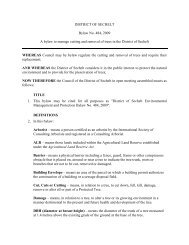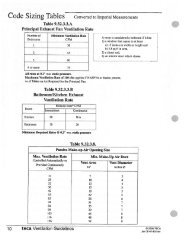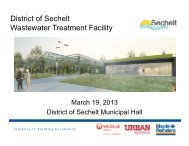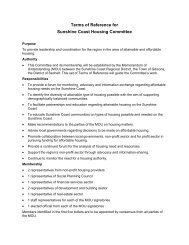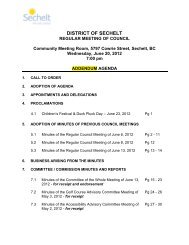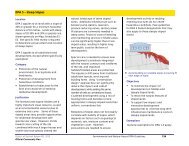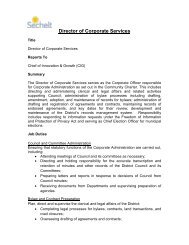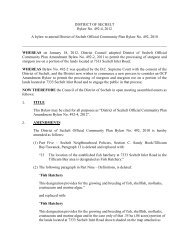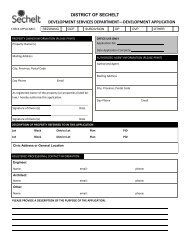District of Sechelt Urban Forest Plan
District of Sechelt Urban Forest Plan
District of Sechelt Urban Forest Plan
You also want an ePaper? Increase the reach of your titles
YUMPU automatically turns print PDFs into web optimized ePapers that Google loves.
<strong>District</strong> <strong>of</strong> <strong>Sechelt</strong> <strong>Urban</strong> <strong>Forest</strong> <strong>Plan</strong> 2010<br />
Benefits <strong>of</strong> <strong>Urban</strong> <strong>Forest</strong>s<br />
Human Health Benefits<br />
Treed landscapes:<br />
a. Enhance psychological well-being. Studies show that desk workers who can see natural<br />
areas report greater job satisfaction and have 23% fewer sick days. Hospital patients<br />
recover more quickly when their room <strong>of</strong>fers a view <strong>of</strong> trees. (Kuo 2003; Kaplan & Kaplan<br />
1989 in Wolf. K.L. 1998; Ulrich 1985 in Wolf. K.L. 1998).<br />
b. Improve air quality by filtering out dust, airborne pollutants (such as sulphur dioxide),<br />
and particulates (such as pollen and mold spores). A mature tree absorbs 54–110 kg <strong>of</strong><br />
small particles and gases <strong>of</strong> air pollution each year. In addition they provide oxygen to<br />
breathe. A single mature tree can provide enough oxygen for two people for a year (UBCM<br />
2008; Wolf, K.L. 1998).<br />
c. Improve water quality. Tree roots take up potentially harmful chemicals such as nitrates,<br />
phosphorus and cadmium that would otherwise enter groundwater and streams (UBCM<br />
2008).<br />
d. Supports walk able neighbourhoods, and active transportation. <strong>Urban</strong> forests—<br />
including street trees and parks—encourage people to get out <strong>of</strong> their cars and walk or<br />
bike (UBCM 2008).<br />
e. Act as sound barriers, reducing noise from highways, local industry, and neighbours (ISA<br />
2005).<br />
f. Moderate climate by dampening the effects <strong>of</strong> the sun, wind, rain, and pollution (UBCM<br />
2008; MOE 2006; Bell and Wheeler 2006).<br />
i. Sun: Leaves absorb and deflect sunlight- providing shade and cooling. The larger the<br />
tree the greater the cooling effect.<br />
ii. Wind: Trees can change the speed and direction <strong>of</strong> winds helping to protect homes,<br />
animals, and crops.<br />
iii. Rain: Trees reduce storm water run<strong>of</strong>f and prevent flooding by intercepting, and<br />
storing water. Dew and Frost are less common under trees.<br />
iv. Pollution: Shade trees reduce temperatures, slowing the formation <strong>of</strong> ground-level<br />
ozone (smog).<br />
November 2010 Page 12





